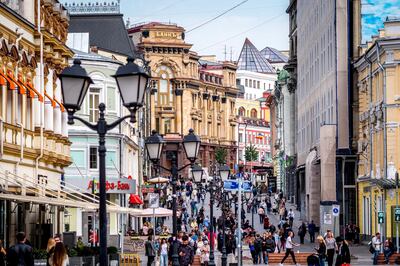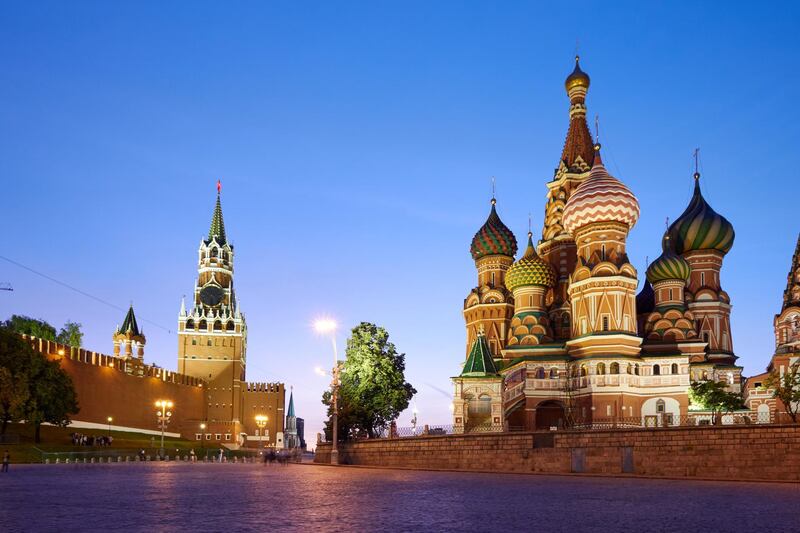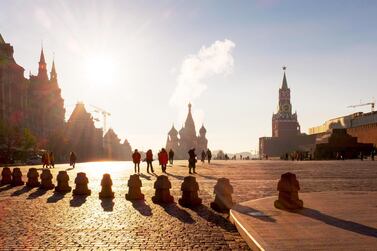Moscow dwarfs you. Its broad buildings tower over you, its giant squares swallow you and its vast parks envelop you. It is a city like few others. In summer, inhabitants stroll along the city's broad streets or relax in its lush parks. In winter, with temperatures routinely hovering around the -20°C mark, the party moves indoors and underground to the city's cathedral-like metro system.
Above all else, Moscow is old. Since its founding in 1147 on the banks of the river that gives the city its name, through the establishment of modern Russia, through the reigns of tsars, through revolution and economic collapse, Moscow has endured.
Throughout much of its history, Moscow sat upon the fulcrum of international events, with East pushing against West, and the West, for its part, pushing back. Today is no different, with international sanctions hammering the rouble, pushing it at the start of this year to a three-year low against the dollar. In addition to that, UAE citizens can now obtain a visa on arrival in Russia, so for anyone hoping to explore this ancient city that prides itself on its modernity, there has rarely been a better time.
Getting around
Moscow has made huge strides over recent years, not least during its preparations for the World Cup last summer, in catering to visitors unused to either its alphabet or its language. In winter, exploring the city by foot is hardly the best idea, but taxis can be ordered in English, either through Uber or its local equivalent, Yandex Taxi.
To travel by cab, however, is to miss one of Moscow's greatest attractions: its awe-inspiring subway system. The subway was first opened in the 1930s and has been growing ever since. Today, there aren't many places in the city too far removed from a giant, illuminated red "M" that marks a metro entrance. The stations themselves are all breathtaking, but Ploshchad Revolyutsii, with its bronze statue of revolutionary and Soviet life, has always been a personal favourite. Just remember to rub the dog's nose for good luck.
Any trip to the Russian capital is going to require some pretty thorough research beforehand. However, certain sites are going to feature on every itinerary, not least Red Square and the Kremlin. Moscow owes its existence to Red Square (actually a derivation of the Russian word for beautiful, rather than any reference to past Soviet leaders). Originally a marketplace, it was gradually fortified with the wooden walls and garrison that, over time, became the modern Kremlin.
Measuring 330 metres by 70 metres, Red Square is still a pretty formidable space and, for those of a certain age, will be instantly recognisable from the Soviet military parades, when tanks and rocket launchers thundered past the State Historical Museum, Lenin's Mausoleum and the brightly coloured domes of St Basil's Cathedral.
Also worth a look is VDNKh, or the pithily titled Exhibition of Achievements of National Economy. A metro ride out of the city centre, VDNKh sits within a giant park, where pavilions built in the style of the Soviet Union's member states line the broad walkways. Originally, these pavilions housed exhibitions celebrating the achievements of each member state. However, today you're more likely to find restaurants, cafes and boutique jewellery stores. Providing you wrap up warm, it makes for an excellent afternoon's walk, not least if you include a trip to the nearby Ostankino Tower, the dizzying 540-metre-high platform from which Russia's television and radio programmes were once broadcast. It is still the tallest free-standing structure in Europe.
The shopping experience
When it comes to shopping, Moscow offers visitors the glamour of any upmarket European capital with the budget of a backpacker. While traditional items such as diamonds and furs look to be weathering the worst of the currency storms, electrical items and other luxury goods are well within grasp and can be found at any of the capital's myriad shopping centres.
Possibly the most impressive of these is the Main Universal Store, or GUM. Taking up almost the entire length of the eastern side of Red Square, its sparkling lights are reflected across the square on to the austere marble of Lenin’s Mausoleum, providing as neat a commentary as you could hope for on how times are changing.

Like the ancient market square it stands on, GUM owes its existence to trade. There’s been a shop here of one kind or another since 1520. Today, there are three storeys of boutique shops, all housed under a soaring glass roof, which arcs over the perfectly coiffured heads of the affluent and acquisitive milling below.
For sheer opulence, the shopping mall that comes closest to rivalling GUM is the Central Universal Department Store, or TsUM, on Theatre Square, near the Bolshoi. Within TsUM’s impressive six storeys are more than 1,000 fashion brands, perfume and jewellery shops, as well as cafes and even the odd humidor. Go in. Relax. Savour some people-watching.
The dining scene
Historically, Moscow hasn't been particularly popular among the world's gourmet set, certainly not while under Soviet rule. However, in recent years, new restaurants have sprung up, offering unique takes on traditional dishes.
CDL on Povarskaya Street is a decent example of how delicious traditional Russian food can be. With a typical meal costing about $50 (Dh184) per head, excluding drinks, it's a little pricier than the average Russian eatery, but the service and decor justify the difference. World leaders from both East and West have dined here, with the restaurant still a favourite meeting point for Moscow's beautiful people. The room itself is designed to conjure the feeling of a Russian boyar's house. Also pay particular attention to the staircase in the restaurant's main oak hall; there isn't a single nail or screw within it.
However long you stay, a trip to Moscow is always going to be eventful. Whether you're walking in the footsteps of the tsars or the USSR's general secretaries, the memories will remain long after you've brushed the snow off your boots.Elsewhere, a typical meal can usually be picked up for about $10 per head, excluding drinks. You can find restaurants around Moscow offering cuisine from throughout the former Soviet Union, so don't be afraid to eat around. A personal favourite has always been Georgian food, which has returned to the capital after a prolonged absence.











